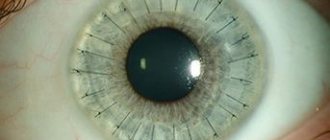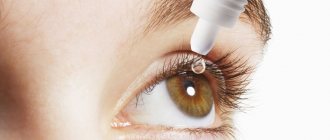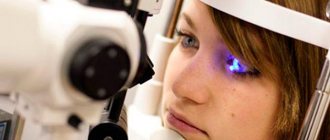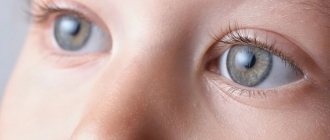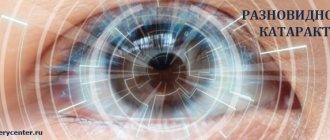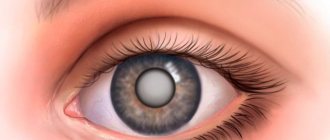- The operations are carried out in Yaroslavl, in an inpatient department. A cataract
is a clouding of the lens of the eye. The lens is a living lens located behind the iris. With cataracts, a cloudy lens blocks the passage of light and makes the visible image blurry, colors dull and distorted. Vision decreases at dusk and at night. Glasses or conservative treatment for cataracts do not help. The only effective way to treat cataracts is surgery, during which the cloudy lens is removed and replaced with a clear artificial one.
Advantages of surgery at Realize Clinic:
- The operation can be performed either on an outpatient basis or in a hospital. This depends on the expected complexity of the operation itself and the patient’s concomitant diseases.
- Experienced surgeons who have performed thousands of similar operations.
- No seams. The operation is performed through a self-sealing micro-incision.
- The operation time is 10-15 minutes. Only local anesthesia in the form of drops is used.
- Our operating room is equipped with a sterile air supply system, which provides high protection for the patient from infection during surgery.
- High-precision calculation of IOL (artificial lens).
- All types of modern artificial lenses, including Alcon (USA).
- We perform operations with the installation of a multifocal lens (Alcon ReSTOR), which allows you to get good vision without glasses at any distance at any age.
- Preoperative examination in one hour.
- We issue sick leave to those who work.
IMPORTANT! Realize is the only non-state ophthalmology clinic in the Yaroslavl region with a 24-hour inpatient department. This means that if you need round-the-clock monitoring of your condition, only we have all the necessary conditions for this.
If you have cataracts, you only need 3 steps to restore your vision:
Diagnostics
A few days before the operation, the doctor must talk about all its stages. It is important for the surgeon to have information about all medications taken by the patient to determine their possible effect on anesthesia.
READ MORE: Eye swelling after cataract surgery Rehabilitation after surgery VISION RESTORATION
When a cataract is successfully removed, the patient does not experience pain after the operation, but if pain occurs, the anesthesiologist administers sedatives to the patient. The operation lasts approximately 15 minutes, and the patient may feel slight pressure in the eye from the surgical instruments inserted into it.
Rehabilitation
Diagnosis: cataract
A look through the waterfall - Tamara Vasilievna, what kind of disease is this - cataracts? Why does it affect the eye? – Cataract is clouding of the lens. The lens is like a lens that transmits and refracts light rays. It is located in the pupil area behind the iris and consists of proteins and water. The lens focuses the resulting image onto the retina. If the picture is clear, a signal is sent to the corresponding visual lobes of the brain. With age, the transparency of the lens changes. This is why, after forty, many people notice that they can no longer read a newspaper or book without glasses, because farsightedness develops. As for cataracts, with this disease the lens partially or completely becomes cloudy, vision decreases, and a person sees objects around him unclearly, as if blurred... It was not for nothing that the ancient Greeks called this disease - kataraktes, which translated means waterfall.
– But not all older people develop cataracts. Perhaps there are some reasons for this? – In young people, clouding of the lens can be caused by injuries, the presence of endocrine diseases also plays a role here - diabetes mellitus, thyroid dysfunction... The lens reacts in a similar way to poisoning by toxic substances. Cataracts often develop in people working in “hot” shops. And lately, the aggressive sun has also played a negative role. But the main reason for the development of cataracts is still the aging of the body. With age, metabolic processes in the body are often disrupted; they lead to the fact that the lens begins to thicken and lose its elasticity.
How to recognize the disease - What are the first symptoms of the disease? – A person suddenly notices that he sees objects through a certain haze, they are blurry and indistinct. Later, as the disease develops, flies begin to flicker before the eyes, halos appear around objects in bright light, photophobia, and double vision. People have difficulty reading and writing, and it becomes more difficult for women to sew or knit. As the cataract matures, the color of the pupil changes from black to white.
– Why is this diagnosis being made so often today? – To a certain extent, because cataracts are getting younger, and besides, not everything is in order with the environment... In addition, the capabilities of ophthalmologists in terms of diagnostics have improved significantly. In Yaroslavl, every district clinic is equipped with special microscopes and other modern equipment that allows for timely diagnosis of cataracts. But before, the patient regularly came to see the doctor, and the doctor, examining him, said: “You still have immature cataracts, come back in three months.” As a result, an able-bodied person rapidly lost his qualifications, and it was also not easy for him in everyday life; with the development of blindness, he lost interest in life - after all, we receive 90 percent of the information about the world around us through vision. Today we do not wait for cataracts to mature; we operate on them at the initial stage. There are currently no medications that can stop the growth of cataracts. So conservative treatment is ineffective here and surgery cannot be avoided anyway.
When to have surgery – So, if I have a cataract, then I need to prepare for surgery? - Yes. But this issue must be resolved with the attending physician. If the patient’s vision has decreased and the patient’s vision is poor, we advise him not to postpone the operation. Today there are a variety of options for solving the problem. Let’s say that by implanting an artificial lens into a person who spends most of his time driving, we do everything possible so that he can see perfectly in the distance, but for near visions we can use glasses. But someone, on the contrary, needs to see perfectly what is located directly in front of their eyes, which means doctors must also take this into account... However, today bifocal lenses have appeared that allow you to see perfectly both near and far.
– How are such operations performed? – They are performed under local anesthesia using the most modern equipment using ultrasound. I will try to explain the technology so that your readers can understand it. So, first the damaged lens is removed. Previously, an incision was made for this, and then after the operation sutures were placed, which were removed after a certain period of time. But such operations did not provide the opportunity for maximum improvement of vision, since the sphericity of the cornea of the eye was disrupted... Today we work differently. An ultrasound tip is applied to the lens through a microscopic puncture. The lens itself is in a transparent capsule, it must be removed and the contents “broken” with ultrasound into the smallest “pieces”. Then all this is washed out of the eye with the help of a large amount of liquid, and as a result of all manipulations, only an empty capsule remains, into which the new lens is “placed”. All. No stitches and minimal postoperative complications.
We calculate the risks - And yet, how great is the risk for a patient who decides to undergo surgery? – Any operation is a risk. But in our clinic, the percentage of complications after surgical interventions is minimal and does not exceed one percent out of a hundred. This is higher than the Russian average. Speaking about possible complications, one should rather take into account the general condition of the patient, the features of the anatomical structure of his eye, and finally, the presence of concomitant diseases and age. The fact is that today we do not refuse surgical assistance to almost anyone, and just a few years ago people over 70 years old could not even dream of such an operation, just like those who suffered from diabetes mellitus, glaucoma... At the moment, everyone restrictions have been lifted.
– How much does such an operation cost? – For residents of Yaroslavl on a first-come, first-served basis – free. It should also be explained that we work within the framework of the municipal order, its annual volume is 1800 operations per year. Today we are registering patients for January 2012, since this limit has already been exceeded.
Imported or domestic? – Tamara Vasilievna, but not all of your patients agree to implant a domestic lens; there are also those who prefer imported samples? – As a rule, we use imported soft artificial lenses, and depending on their merits (quality of material, design), they have a significant price range. It is important to clarify: if a patient wants to get an imported lens, he will also have to pay for the operation itself. It costs about ten thousand, plus almost the same amount you have to pay for the American lens, which is used most often.
“But there are patients for whom implantation of only an imported lens is indicated, but they do not have that kind of money for the operation. What should they do? “Special quotas will be allocated for such patients, so that they will undergo the operation that is necessary.
– Tell me, is it possible for patients to buy a lens for themselves? – Yes, no problem, our doctors will write which one you need for the operation.
– Tell me, wouldn’t it be like this: a person had an operation, and after a few years he needs to repeat it? – If you install a good imported lens, such a scenario is almost completely excluded. How to make an appointment
– How can I get an appointment with specialists at your center? - Very simple. An ophthalmologist at a district clinic examines a patient and decides that he needs surgery. He writes the appropriate direction, with which the person first comes to the reception desk, and then, having received a coupon indicating the date and time of the appointment, goes to our center. We have several advisory departments. Doctors examine the patient, confirm the diagnosis and put him on the waiting list for surgery. The person takes the necessary tests, undergoes a polyclinic examination and comes to the operation with all the documents on the appointed day. According to the World Health Organization, about 17 million people suffer from cataracts, mostly after 60 years of age. At the age of 70–80 years, cataracts are present in 260 men and 460 women out of 1000 people, and after 80 years - in almost everyone. Cataracts have caused blindness in nearly 20 million people.
Types of operations
| Excimer laser vision correction during surgery on both eyes | |
| Excimer laser vision correction for myopia, astigmatism, hypermetropia using the LASIK method (price for both eyes) | 37,000 rub. |
| Excimer laser vision correction during surgery on one eye | |
| Excimer laser vision correction for myopia, astigmatism, hypermetropia using the LASIK method | 21,000 rub. |
| Excimer laser vision correction for myopia (taking into account astigmatism), hyperopia using PRK method | RUB 17,250 |
| Phototherapeutic keratectomy (PTK) | 8,000 rub. |
| Laser surgery on the retina (laser coagulation of the retina) | |
| Barrage of the macular zone | 4,200 rub. |
| Barrage of holey defect in the macular zone | 5,000 rub. |
| Barrage of the exudative detachment zone | 6,700 rub. |
| PLKS of the 1st category of complexity (includes barrage of 1-2 lesions without laser cerclage) | 4,000 rub. |
| PLKS of the 2nd category of complexity (includes barrage of more than 2 lesions without laser cerclage) | 4,500 rub. |
| PLKS 3 category of complexity (includes barrage of lesions with laser cerclage) | RUB 7,800 |
| PLKS carried out in two stages, stage I | 7,000 rub. |
| PLKS, carried out in two stages, stage II | RUB 3,700 |
| Barrage of local detachments during PLKS of categories 1-3, carried out in one stage | RUB 2,900 |
| Barrage of local detachments during PLKS performed in two stages | 1,500 rub. |
| Barrage of the retinal detachment zone, stage I | 6,000 rub. |
| Barrage of the retinal detachment zone stage II | 4,500 rub. |
| Focal laser photocoagulation of the retina | RUB 5,200 |
| Sectoral laser coagulation of the retina | RUB 5,700 |
| Panretinal laser coagulation of the retina Stage I | 6,800 rub. |
| Panretinal laser coagulation of the retina stage II | 4,700 rub. |
| Panretinal laser coagulation of the retina stage III | RUB 3,700 |
| Laser therapy | |
| Micropulse therapy (MILT) test session | RUB 5,500 |
| Micropulse therapy (MILT) II session | RUB 5,500 |
| Micropulse therapy (MILT) III and subsequent sessions | 3500 rub. |
| Phacoemulsification of cataracts | |
| Phacoemulsification of cataracts with implantation of a domestically produced intraocular lens | RUR 21,500 |
| Phacoemulsification of cataracts with implantation of an Alcon intraocular lens | RUR 26,800 |
| Phacoemulsification of cataract with implantation of Alcon intraocular lens with filter | RUB 27,500 |
| Phacoemulsification of cataracts with implantation of premium Alcon IQ intraocular lens | RUB 31,500 |
| Phacoemulsification of cataracts with implantation of a premium Alcon toric intraocular lens (lens with the ability to correct astigmatism) | RUB 41,900 |
| Phacoemulsification of cataracts with implantation of a premium Alcon multifocal intraocular lens (the lens allows you to see well both at distance and near without glasses) | 62,000 rub. |
| Phacoemulsification of cataracts with implantation of a premium Alcon multifocal toric intraocular lens (the lens allows you to see well both at distance and near without glasses, and also corrects astigmatism) | 94,000 rub. |
| Implantation of an anterior chamber intraocular lens | 19,000 rub. |
| Removal of the intraocular lens | 11,000 rub. |
| Eyelid surgeries | |
| Chalazion removal | 5,000 rub. |
| Pterygium removal | 6,500 rub. |
| Removal of papilloma | 5,000 rub. |
| Correction of entropion | 4,000 rub. |
| Removal of xanthelasma | 4,000 rub. |
| Dilatation of tear ducts | 2,000 rub. |
| Procedures and injections | |
| Cryotherapy | RUB 3,500 |
| Administration of the drug into Tenon's space (cost of one injection excluding the cost of the drug) | 2,300 rub. |
| Intravenous injection | 450 rub. |
| Intramuscular injection | 250 rub. |
| Injection into the chalazion, taking into account the cost of the drug | 1,500 rub. |
| Parabulbar injection | 680 rub. |
| Subconjunctival injection | 250 rub. |
| Lacrimal duct rinsing for adults | RUB 1,150 |
| Removal of corneal foreign body | RUB 1,900 |
| Eyelid massage | 350 rub. |
| Intravitreal administration of drugs | |
| Administration of the drug Lucentis (cost of one injection including the cost of the drug) | RUB 32,900 |
| Administration of the drug Aflibercept (Eylea) (cost of one injection including the cost of the drug) | 27,000 rub. |
READ MORE: Cataract symptoms of eye disease. Signs of eye cataracts, symptoms and treatment methods.
You can also try to get the operation to be performed under the VHI policy, but in this case the artificial lens will be placed for an additional and very significant fee.
On average, in all regions of Russia, the cost of the operation reaches about 30 thousand rubles. If you have the desire and opportunity, then it is better to choose a Premium class lens. The price of the lens will then be approximately 80 thousand rubles, and the cost of the operation must also be added here.
the average cost of an operation reaches about 30 thousand rubles
You cannot joke with this disease and with your own health by biding your time, but you should immediately consult a doctor when you notice the first symptoms.
The stages of rehabilitation are divided into several parts. The initial stage is the first week after surgery. Accompanied by eye pain, discomfort, swelling. To correct disorders, painkillers and anti-inflammatory drugs are prescribed.
The second stage is from 8 to 31 days. This stage requires strict adherence to the diet and the implementation of individual doctor’s recommendations. It is important to take care of your eyes!
The third stage begins on day 32. From this moment on, experts expect complete restoration of visual functions. To correct disorders, contact lenses or glasses are used.
To prevent recurrence of cataracts, procedures are used to prevent re-opacity of the lens. When in the sun, protect your eyes from ultraviolet radiation. Experts recommend protecting intraocular tissues from peroxide forms of oxygen. For these purposes, antioxidant complexes are prescribed, including vitamins A, C, and E. It is better to consume these substances as part of natural products.
Regular examinations by an ophthalmologist allow early detection of pathological disorders.
Due to the fact that medicine is rapidly developing, cataract removal is not such a big problem now. But, in fact, if a cataract is detected, the cost of the operation is not so small, which significantly narrows the chances of defeating the disease for people with low incomes.
READ MORE: Which is better milgamma or cyanocobalamin
free operations are no different from commercial ones in their effectiveness and safety
Your doctor may also recommend using a bandage for a certain period of time to protect your eyes from exposure to light to avoid complications. It is optimal to use disposable dressings; they can be purchased at almost every pharmacy.
It is possible to make a bandage yourself, for which you will need to purchase a patch and a sterile gauze scarf. The patch is glued to the napkin horizontally, and an additional layer must be laid on top of the soft layer for protection.
What is cataract surgery?
This is one of the safest and most successful procedures performed in our center today. Modern high-tech equipment and the enormous experience of our specialists have made it possible to reduce all possible risks associated with surgery, making this operation simple, well-tolerated, painless and quick (10-15 minutes).
During the operation, a small (about 2 mm) incision is made along the edge of the cornea, through which the surgeon, using a micro-instrument, crushes the cloudy lens with ultrasonic waves and removes it from the eye, after which an artificial lens is installed through the same micro-incision.
Diagnosis of cataracts
To make a diagnosis, the doctor must conduct a standard ophthalmological examination, including testing visual acuity and biomicroscopy of the eye using a slit lamp.
To date, there are no proven methods of treating cataracts other than surgery. Modern technologies make it possible to quickly, painlessly and with a low risk of complications get rid of this disease and restore lost vision. The global standard for cataract treatment is phacoemulsification. In this case, a micro-incision is made in the eye through which an ultrasonic needle is inserted, which destroys the substance of the lens and removes it. After complete removal of the lens, an intraocular lens (artificial lens) is implanted into the eye. The transparency of the media is restored and the patient regains vision.
The Vista ophthalmology clinic has everything necessary for the diagnosis and treatment of cataracts. Calculation of IOL optical power is performed using the latest Alladin HW3.0 biometric system.
Modern technologies and the availability of a wide range of medications allow this operation to be performed on an outpatient basis. Only very rare cases require hospitalization of the patient in a hospital. In our clinic, the operation is performed using the latest generation Stellaris PC Vision Enhancement System microsurgical system. This operation is performed under local anesthesia, which allows the patient to return to their normal lifestyle in the shortest possible time. And, getting better and higher-quality vision, make it brighter and happier.
Ophthalmology department
with a day ophthalmological hospital, it has 80 beds for round-the-clock patient care and 15 day hospital beds, providing emergency and planned qualified ophthalmological care.
Telephone 73-27-81 The department is equipped with modern equipment that allows performing high-tech operations for cataracts with the implantation of soft artificial lenses from leading global manufacturers, including lenses that relieve presbyopia and astigmatism.
We recommend reading: Air defense part of carpets
Modern methods of glaucoma surgery have been mastered. Surgeries are performed for retinal detachment and other pathologies of the visual organs.
Ophthalmological center "OftaKIT"
Ophthalmological is an ophthalmological Clinic of Innovative Technologies in Yaroslavl. Innovation is available to everyone - this is our main operating principle.
On the territory of OftaKIT, a maximum of advanced world-class technologies in the field of ophthalmology have been collected, which have no analogues in the region. The clinic is multifunctional; patients of any age come to us. You do not have to turn to third-party organizations; all possible ophthalmological procedures will be performed with us: from diagnosis to the necessary treatment, including surgery.
This is possible because we have doctors of the highest level working with us, and all areas are supervised by Professor V.V. Strakhov, the head of the clinic, which ensures the highest level of ophthalmological services.
The location in the historical center of the city allows patients to conveniently reach the ophthalmology center from anywhere in the city.
The clinic has three departments: adults, children and optometry. Services:
- Outpatient sutureless cataract surgery with implantation of intraocular lenses from standard to complex multifocal ones, allowing the patient to have good vision both at distance and near, never having to use glasses again.
- Laser vision correction using advanced techniques CustomLasik (personalized operations), LeptoLasik (operations with the formation of a thin corneal flap).
- The most modern set of equipment for diagnosing and monitoring glaucoma and unique laser anti-glaucoma operations SLT - selective laser trabeculoplasty.
- Qualified specialists. Our doctors constantly improve their skills, participate in conferences, and try to keep abreast of the latest achievements in ophthalmology.
- Complex methods of treating diabetic retinopathy and other retinal diseases using laser coagulation of the retina and intravitreal injections of the latest drugs (Lucentis, Aflibercept, Ozurdex).
- A large children's department actively involved in the prevention and treatment of myopia, farsightedness, and astigmatism, including with the help of night OK lenses. As well as other diseases of the organ of vision in children and adolescents.
- The only optometry department in the city and region, whose specialists are able to select glasses and lenses of any complexity, including those with concomitant eye pathologies.
- More than 20,000 patients applied in two years of the clinic’s operation, more than 5,000 microsurgical operations were performed, including excimer laser vision correction.
Contacts: Adult department
Yaroslavl, st.
Svobody, 42 +7 (4852) 745-645 Children's department
Yaroslavl, st.
Tchaikovskogo, 32 +7 (4852) 945-245 Department of Optometry
st.
Tchaikovskogo, 32 +7(4852) 59-38-70 Working hours: Mon-Fri: from 9:00 to 19:00 Saturday: from 9:00 to 15:00 Sunday closed
What is the cost of the operation?
The cost of the operation can vary not only in different centers, but also in the price list of one clinic. Even operations performed by the same surgeon can vary greatly in price. What could this depend on? During the operation, many different consumables are used, the quality and cost of which vary significantly. A special role is played by the choice of an artificial lens (IOL), the price of which can vary from 2-3 thousand to several tens of thousands of rubles. Inexpensive lenses provide quite decent postoperative results, but after several years they can change their properties and cause vision loss or the development of secondary cataracts. By replacing a cloudy lens with an artificial one, we can not only restore the vision you had in your youth, but also improve it, eliminating the need to wear glasses, even if you have worn them all your life! Bring back the youth of your eyes - see well into the distance and read without glasses - today we can do it!
Treatment of cataracts in Yaroslavl
loading.
apismf
Cataract. Folk recipes
Official medicine uses drops for treatment, which, although they do not lead to a complete cure, slow down the process. Alternative medicine suggests starting with the treatment of gastrointestinal diseases, conducting a series of diaphoretic procedures that will help establish internal metabolism.
It is proposed to treat the lens not only with celandine juice, but also with honey and lemon. Take a mixture of honey and lemon juice in a 1:1 ratio and keep warm for at least 2 weeks, then drop this fermented mixture into the eyes 3 times a day, 1 drop.
Honey is diluted in a ratio of 1:3 with boiled chilled water. They should be instilled with 10-day breaks, then repeat the course of treatment. During the hot season, “honey” treatment should be stopped so as not to provoke conjunctivitis.
I made eye drops for myself and use them in the treatment of cataracts. This recipe is quite simple, but requires careful adherence to all recommendations for production and use.
Take a large green apple (Antonovka is the best), cut off a 2 cm thick cap from the side of the stalk. Then carefully, without piercing the apple, remove the core with a teaspoon.
Place 2 teaspoons of honey into the resulting cavity and cover with a cut apple lid, which is secured with two toothpicks.
Place the apple prepared in this way on an empty, thoroughly washed glass to “ripen” the medicine.
• Grind a few leaves of red geranium, squeeze out the juice through gauze and drop 1-2 drops into each eye for cataracts. The condition of the lens improves.
• Make lotions from fresh cucumbers. Pour half a cup of cucumber peels into 1/2 cup boiling water, add a little soda (use as a lotion).
Take the medicine every day for a month. This is very good eye support.
• If you want to improve your vision, you must eat right. It is useless to do eye exercises and at the same time not give them proper nutrition. The diet should include vegetables and fruits, apple cider vinegar, honey, eggs (yolk), fish, yeast.
The figures below show the difference in vision capabilities between a sick and healthy person.
Surgical treatment of cataracts
Eye drops do not help get rid of cataracts!
Drops can only stop its development. Treatment of cataracts is only surgical!
The only effective treatment for cataracts is surgical removal of the cataract and implantation of an artificial intraocular lens instead.
Rehabilitation after cataract surgery takes several weeks and allows almost complete restoration of visual function.
For the treatment of cataracts without surgery (if contraindicated), folk remedies are recommended to prevent the progression of the disease.
loading.
apismf
Cataract. Folk recipes
Official medicine uses drops for treatment, which, although they do not lead to a complete cure, slow down the process. Alternative medicine suggests starting with the treatment of gastrointestinal diseases, conducting a series of diaphoretic procedures that will help establish internal metabolism.
It is proposed to treat the lens not only with celandine juice, but also with honey and lemon. Take a mixture of honey and lemon juice in a 1:1 ratio and keep warm for at least 2 weeks, then drop this fermented mixture into the eyes 3 times a day, 1 drop.
Honey is diluted in a ratio of 1:3 with boiled chilled water. They should be instilled with 10-day breaks, then repeat the course of treatment. During the hot season, “honey” treatment should be stopped so as not to provoke conjunctivitis.
I made eye drops for myself and use them in the treatment of cataracts. This recipe is quite simple, but requires careful adherence to all recommendations for production and use.
Take a large green apple (Antonovka is the best), cut off a 2 cm thick cap from the side of the stalk. Then carefully, without piercing the apple, remove the core with a teaspoon. Place 2 teaspoons of honey into the resulting cavity and cover with a cut apple lid, which is secured with two toothpicks. Place the apple prepared in this way on an empty, thoroughly washed glass to “ripen” the medicine.
• Grind a few leaves of red geranium, squeeze out the juice through gauze and drop 1-2 drops into each eye for cataracts. The condition of the lens improves.
• Make lotions from fresh cucumbers. Pour half a cup of cucumber peels into 1/2 cup boiling water, add a little soda (use as a lotion).
Take the medicine every day for a month. This is very good eye support.
• If you want to improve your vision, you must eat right. It is useless to do eye exercises and at the same time not give them proper nutrition. The diet should include vegetables and fruits, apple cider vinegar, honey, eggs (yolk), fish, yeast.
The figures below show the difference in vision capabilities between a sick and healthy person.
What is an artificial lens (Intraocular lens (IOL))?
An artificial lens or intraocular lens (IOL) is an artificial replacement lens that is implanted into the eye during cataract surgery and replaces the cloudy lens. IOL manufacturing technologies are evolving and can provide good quality vision to patients with different indications. In our work, we use all the most modern IOLs from the world's leading manufacturers - lenses with light filters, which allow us to protect the retina from ultraviolet irradiation and preserve the natural perception of colors, toric lenses - which allow us to correct astigmatism, multifocal lenses - for good vision at distance and near without the help of glasses!
Quota for eye lens replacement
Malignant and non-malignant formations of the orbit, regardless of whether exacerbations are present or not. Congenital anomalies of the components of the organ of vision (lens, cornea, muscle tissue, anterior or posterior segment of the eye, etc.), as well as deficiencies in the structure of the lacrimal apparatus, abnormalities of the eyelids.
Errors in the structure of the anterior chamber of the eye caused by cataracts. In this case, the doctor performs laser treatment with further installation of an intraocular lens. Secondary cataract, which led to pathologies of the retina, lens, and choroid. Lasers are used to treat this disease. At the same time, measures are taken to eliminate complications. There are two methods of obtaining a quota for surgical treatment of cataracts: through the health authority, and directly through the state medical institution where glaucoma is treated.
But, in any case, the first authority is the local doctor.
Causes
The reliable basis for the formation of eye cataracts is still not known, and operations are carried out only on the basis of changes in the composition of protein components, leading to a gradual clouding of the lens.
- Genetic diseases;
- Eye injury;
- Inflammatory processes in the optic nerves;
- Exposure to ionizing radiation.
- Previously performed operations on the organs of vision;
- Excessive ultraviolet exposure;
- Diabetes;
- Smoking tobacco and using certain medications;
A disease such as cataracts, the symptoms of which include visual impairment, discomfort in bright lighting, myopia, decreased apparent brightness of colors, double vision, is a very dangerous disease.
At an early stage of the disease, it is still possible to choose glasses to improve vision, but with progressive cataracts, vision becomes increasingly blurred over time and cannot be corrected.
The disease can also develop gradually, without any symptoms.
